Projects 2022-23
TITLE: Myoelectric Prosthetic Hand Using Muscle Sensor And Arduino For Trans-Radial Amputees
Name of the Students
1. Devika Ghadage
2. Rutu Bagde
3. Mohini Dhadi
4. Chaitali Barhate
Abstract: Many people now-a-days are facing amputation in their early 20s or 30s, mainly because of a lack of awareness regarding quality measures to be used while mining coal mines or in various industries. Different types of amputees have to tackle different day-to-day problems. The majority of amputees are people who have lost their arms, legs, or sometimes both, during military conflicts. There are various types of prostheses available in markets around the world for physically challenged people who have lost an arm or legs to provide a support system and lift their spirits. The prosthetic arm is created and built using 3-D printing and PLA material. We present the idea and implementation of EMG (Electromyography) based upper arm prostheses that can overcome numerous restrictions associated with myoelectric operations. The low-cost prosthetic arm has been examined on amputees in real time, and the results demonstrate that it can grip diverse objects successfully.
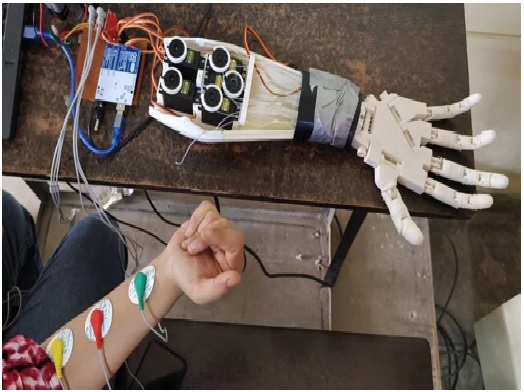
TITLE: DYNAMIC TRAFFIC MANAGEMENT SYSTEM USING IOT
Name of the Students
1. Rashmi Mahadik
2. Sharvari patil
3. Aditi Vaidya
4. Akshata Zope
Abstract: One of the most prominent offshoots of unfolding technologies in this contemporary period is the rapid-fire increase in vehicular counts, which has come somberly in the wake of the stunning soar in the world population. Consequently, it has become a stern problem in most countries and around the world. Due to enhanced business, there turned out to be an unanticipated increase in business log predicament which has rebounded hardship for ambulances in moving cases to the applicable destinations presently in instances of necessity. Statistically, it has been identified that further than 20 cases taking pivotal medical attention die on their way to the sanitarium because of detention. The surfacing inquiries in medical bias, wireless dispatches, detectors, and software operations help in the furtherance of health care centers. In this paper, divergent methodologies are used to enforce mobile android operations for furnishing an efficacious and comfortable ambulance service existence.
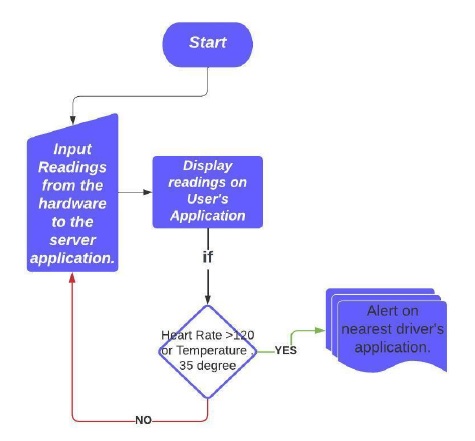
TITLE: IOT Enabled Real Time Monitoring of Air Quality
Name of the Students
1. Anurag Singh
2. Archishmati Sonkamble
3. Zuber Ustad
4. Akash Shukla
ABSTRACT: Generally, air pollution refers to the release of certain substances into the atmosphere that cause discomfort, disease, and death in humans, animals, and the environment. In most developing countries, air pollution reduction and sustainable development are common challenges. With the rapid urbanization and growing number of megacities and urban complexes, new types of research and services are needed. Environmental pollution accidents, especially air pollution accidents, are increasing due to the increase in chemical industrial park construction and production activity because of rapid development of the economy. There is a necessity to examine what the increasing number of megacities means for air pollution, local climates, and the impacts on global climate as a result of the day-to-day increasing number of people living in those areas. In case of incidents related to gas leak, many people from the respective locality are usually unaware until it is too late which results in loss of many lives. Hence, we are implementing the system using IOT analytics platform – Thing-speak which will provide a dashboard to public such that everyone can come to know the Air Quality at the location where the system is installed. Our project is completely portable and user friendly which can be directly implemented wherever required. Thus, by which we are bringing awareness and provide first warning to the people.
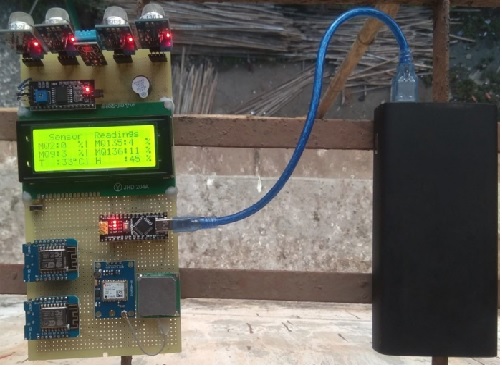
TITLE: EV SCOOTER MOTOR CONTROLLER
Name of the Students
1. Simran Bagwan
2. Sagar Jamadar
3. Yogesh Patil
4. Priyal Thakur
ABSTRACT: The Brushless DC (BLDC) machine is becoming a very popular choice in drive technology over the last few years because of its numerous advantages when com- pared with other electrical machines. Such advantages include low maintenance, high power density, high efficiency and robustness. Because of its numerous ad- vantages the BLDC machine found itself-used in different applications, such as automotive, aerospace, home appliances andHeating Ventilation, and Air Conditioning systems. Over the last decade, low power, low cost and high-speed BLDC machines have also gained popularity in unmanned aerial vehicles (UAV), more commonly known as drones. We will use this E-Scooter Controller to control ourBLDC motor so that we can vary its speed as we like . Our controller will also be connected tothe TFT-Display of the scooter to display things like speed , distance traveled , charging, indicators etc. We will use six-step commutation control scheme to control our BLDC motor which will make use of hall sensors for commutation. A detailed study of communication is covered in ”proposed system” part in this report .
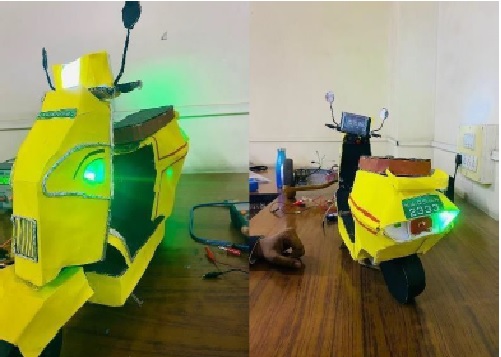
TITLE: License Plate Reader with PUC Details using Image Processing and Deep Learning
Name of the Students
1. Sakshi Deshpande
2. Mohd Hassan Khan
3. Prajakta Mhatre
Abstract: As each vehicle is uniquely identified by its license plate, the Transport System places a high priority on the detection and recognition of license plates. The news is constantly reporting on accidents and missing cars. Authorities must acknowledge all of these unlawful acts. As a result, research into the identification and recognition of vehicle number plates is ongoing. However, identifying a vehicle’s number plate has always been difficult for a number of reasons, such as brightness changes, shadows cast by moving vehicles, erratic license plate character types, different plate styles, and color effects caused by the surroundings. In this system, Number plate of vehicle is detected from a live video or an image. There is image pre-processing and segmentation done on the live video or number plate image. Deep learning model methods are used, the characters from it are separated and then each character gets recognized. This helps to collect the vehicle overall project then the capabilities of different techniques into one integrated automatic system are summarized.
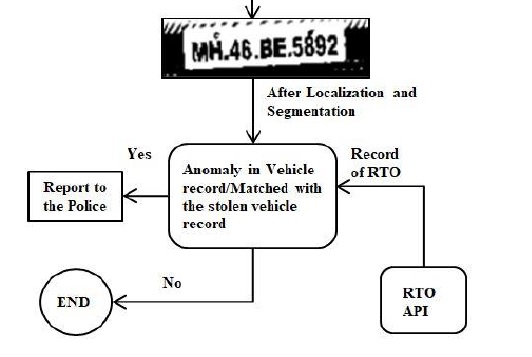
Projects 2021-22
TITLE: DETECTION OF SKIN CANCER USING IMAGE PROCESSING.
STUDENTS NAME: Sushanth Devadiga (BEET A/13)
Pratik Bhowate (BEET A/8)
Harshal Chandorkar (BEET A/9)
Jitesh Donde (BEET A/18)
ABSTRACT: In recent days, skin cancer is seen as one of the most Hazardous form of the Cancers found in Humans. Skin cancer is found in various types such as Melanoma, Basal and Squamous cell Carcinoma among which Melanoma is the most unpredictable. It, a kind of skin cancer, could be a category of cancer that originates from the pigment which includes the cells named melanocytes. Melanomas normally appear within not only the skin, but also may rarely occur within the eyes, intestines, or mouth. In women melanomas most ordinarily found on the legs, on the other hand in men, they are most typical on the rear side. Generally, these are originated from a mole with regarding changes as well as they increase in size, asymmetrical edges, and modification in skin breakdown, itchiness, or color. Melanoma is one of the life-threatening kinds of carcinoma. There is an increase in incidence rates of skin cancer, specifically between non-Hispanic white females and males, however, the chances of survival are high detected in an early stages. Computer vision can play important role in Medical Image Diagnosis and it has been proved by many existing systems. In this project, we are taking the help of the image processing techniques for detecting melanoma in the image. Firstly, we will apply the pre-processing technique in order to make the image noise free. Median filters will be used for filtration of the image. After that, we will transform the image into an HSI color image. Active shape segmentation and texture segmentation techniques will be used for segmenting the image. For feature extraction, GLCM Feature Extraction algorithm is used. Finally, we will apply the probabilistic neural network (PNN) classifier to classify the image either as normal or melanoma.
TITLE : IOT Based Covid Patient Health Monitor In Quarantine
STUDENTS NAME: – Dhanshree Anil Nehete(BEET A/54)
Ankita Dhanaji Kharat (BEET A/38)
Harshada Dyanand Dodke (BEET A/16)
Muskan Nasir Mujawar (BEET A/49)
ABSTRACT:
In times of COVID we have special Covid 19 Quarantine centers setup in order to treat covid patients. Since covid is highly infectious it is very important to quarantine covid patients but at the same time doctors need to monitor health of covid patients too. With the increasing number of cases it is becoming difficult to keep a track on the health conditions of s many quarantined patients.
The problems here are:
▪ Doctors need to regularly monitor patient health.
▪ There are increasing number of patients for the doctors to monitor.
▪ The doctors are at risk of infection just for monitoring purpose.
To Solve this issue we here design a remote IOT based health monitor system that allows for remptely monitoring of multiple covid patients over the internet. The system monitors patient heartbeat, temperature and blood pressure using a heartbeat sensor, temperature sensor and BP Sensor respectively.
The system then transmits this data over the internet using wifi transmission by connecting to wifi internet connection. The data is transmitted and received over IOT by IOT Gecko platform to display data of patient remotely. The entire system is run by a microcontroller based circuitry. If any anomaly is detected in patient health pr if the patient presses the emergency help button on IOT device, an alert is sent over IOT remotely.
This System allows:
▪ Doctors to monitor patients remotely without risk of infection.
▪ A single doctor over 500 patients at a time.
▪ Doctor gets instant alert in case of health fluctuations of emergency.
The system is mounted at patient bedside and constantly transmits patient health data over the internet so that doctors can monitor multiple patients remotely and attend the desired patient urgently when needed.
TITLE :- ADS (ACCIDENT DETECTION AND SAFETY) HELMET
STUDENTS NAME: – Vedant subhash kadam(BEET B/13)
Hemant ravindra chaudhari (BEET B/5)
Chetan rajendra patil (BEET B/29)
Rushikesh uday juikar (BEET B/11)
ABSTRACT:
A smart helmet is type of protective headgear used by the rider which makes bike driving safer than before. The main purpose if this helmet is to provide safety for the riders. This can be implemented by using advanced features like Status of rider wearing helmet, Alcohol detection, Accident identification, Location tracking. this makes it not only a smart helmet but also a feature of smart bike
So main purpose of our system is to reduce accidents by using this system, so here there are some steps to avoid accidents.
1. Identify whether the helmet is worn or not. if helmet is worn then ignition will start otherwise it remains off.
2. The lots of accidents occures just because Drinking and driving case so we are using alcohol detection sytem.
3. So here what makes our sytem different from others, As we know Jarvish gives the best GPS system, Front camera for visibilty, Amozon gives music sytem, BMW gives engine oil level system, WIFI connectivity system ,blutooth But in our sytem will provide safety for riders, If accident happened then alarm will turn ON and gives message to the health care and the family of rider.
TITLE:Accident detection and emergency message dissemination
STUDENTS NAME: Hritik Patil(BEET B/31)
Sandesh Shinde(BEET B/56)
Sushant Pawar (BEET B/38)
ABSTRACT: With the increase in technology and motor vehicle production the number of road accident has increased. The survival rate after accident is very low as proper emergency facilities are not available. Our project would help in detecting an accident and determine its location and the location is dispatched to rescue team and emergency contacts of the rider. The existing models are not reliable as they use vehicle distance between two vehicle provided by certain sensors and does not show concern about speed. Very slow emergency facility can also be a drawback that can be solved by our model.
Projects 2020-21
TITLE : PAYLOAD FOR SOUNDING ROCKET
STUDENTS NAME :- Deven Satam (BEET B/47)
Surya Reddy (BEET B/45)
Aniket Patil (BEET B/27)
Anusha Shetty (BEET B/53)
ABSTRACT: Every aircraft or launch vehicle has a payload system of its own which includes the scientific instruments or other equipment. We aim to build a payload system for a Sounding rocket which specializes in carrying scientific equipment and takes measurements in its sub-orbital flight. Our project focuses on building the payload system whose main objective is to gather the required data and transmit it to the ground station. In this case we aim to find information about temperature, pressure, altitude as well as acceleration and gyroscopic data. As per the requirement of the sounding rocket, this payload consists of three sections. The first part would be to determine the sensors. The next part is transmission which includes the oscillator, modulator and a patch antenna to transmit the data gathered. The last part would be detection of the signals at the ground level with the help of a demodulator. Since the height of the flight is less than 15 kilometers from the ground, only small battery source is sufficient. In case of future expansion solar panels are an option for longer travel distance. This being the main objective of the payload system, it will be used to gather atmospheric and weather conditions with the launch vehicle making it cost efficient.
TITLE : Electronic Eye Smart Stick: An assistant and helping hand for visually impaired
STUDENTS NAME: – Apurva Desai (BEET A/12)
Rutiksha Jadhav (BEET A/27)
Anshu Jha (BEET A/30)
Poonam Masal (BEET A/45)
ABSTRACT: There are 2.2 billion people blind and numbers are rising day by day. Technologies are emerging very rapidly which are boon to mankind and blind people should also be part of growing world. The Electronic Eye Smart Stick: An assistant and helping hand for visually impaired is a intelligent and significant equipment for blind people. The basic version of the project included features like detection of obstacles, water and had one more feature to send alert message. We will try to modify the stick by changing the material of stick. We will embedded Google Map Navigative feature. The alert message will be sent twice to family members. Our proposed project uses different types of sensors which are ultrasonic sensor to detect different obstacles and soil moisture sensor to detect presence of water in path of blind people. This stick also sends the user’s location to their family by using GPS-GSM module. An Ardunio Uno is used for communication between the components and software application for sending messages. The proposed system operates on 9V/12V. It can scan the surrounding and rise appropriate auditory and vibratory alerts. It can detect the wet surface and alert the user and also send SMS to family in case of any emergency. This combined solutions, will try to solve problem of navigation for blind people.
TITLE: E-ventilator (Emergency ventilator) for Emergency situations.
STUDENTS NAME: –SAURABH SHARAD KHARADE– (BEET B/15).
–KSHITIJA BALARAM PATIL– (BEET B/32).
–MANISH RAJU PATIL– (BEET B/33).
–KABIR DILIP LOKHANDE– (BEET B/17).
ABSTRACT: Human lungs use the reverse pressure generated by contraction motion of the diaphragm to suck in air for breathing. A contradictory motion is used by a ventilator to inflate the lungs by pumping type motion. The ventilator here we design is to help people during Emergency situations. It is very low cost and affordable. When people suffer from lungs or breathing problem this can be used. In this we use Motor mechanism to push the air bag. When oxygen level counts are low this mechanism can be used. Here we also use temperature sensor and electrocardiograph (ECG) sensor to find the temperature of patient and the heart rhythms and electrical activity. Small screen is used to display the oxygen levels and electrocardiograph. And a buzzer is fitted to detect any low levels of oxygen count. The entire system is driven by an Arduino microcontroller.
TITLE : Di- farm robot
STUDENTS NAME:Kiran Navnath Shinde (BEET B/55)
Adesh Pawar (BEET B/37)
Prajwal Hande (BEET B/09)
Vinayak Songekar (BEET B/ 63)
ABSTRACT : Agriculture is the major sector upon which 70% of the population is dependent directly or indirectly. There were not many advancements seen in this sector as globalization is not much. But in the past few decades, there has been immense development in this sector and the whole process is about to be automated. The last decade has seen massive developments in the field of agriculture. From automatic tractors to crop monitoring systems we are now seriously considering the possibility of completely autonomous vehicles that can pretty much conduct themselves with minimal human intervention. Although tremendous research has gone into this discipline, the lack of knowledge and awareness among the farmers are big influencers in terms of how this technology can be brought to its flaws. Over the last few years after the launch of autonomous robots, many farmers have witnessed an increase in the yield and production of crops. We aim to understand this technology and to comment on how these technologies may be perfected or analyze if they can be perfected at all to the point where they can deal with various agriculture hazards with the help of intelligent algorithms.
Title : Smart bus stop
Name:
1. Nidhi Kishor Vavekar (BE ET- B / 76)
2. Pratibha Pradip Thakur (BE ET-B/ 73)
3. Rajanandini Dilip Tambe (BE ET- B/ 67)
4. Shivani Shivendra Sinha (BE ET-B/ 60)
Abstract: In today’s world, especially in our country, India, there are smart systems available for train platforms and trains that allow us to know when a specific train is arriving and at what time it is arriving, but there is no such system for bus transportation, which is where the majority of the population travels. When buses are late, it certainly causes havoc. This project will implement a bus system that will notify us of the arrival time of the bus at that specific bus stop. There will be two systems for this, one at the bus stop and the other on the bus itself. A message will be delivered to the specific bus stop and displayed on the LCD as well as on the voice module as an indication. The wireless module connects the communication between the bus and the bus stop. This will be basically a transmitter- receiver circuit implemented for the good of daily life travel with ease.
Projects 2019-20
Title: Accident Prevention control system and Detection of Lost key
Student Names: Saurabh Bapat, Dewang Dudhavadkar, Alok Gonnade, Amit Naik
Accident prevention control system and detection of lost key is a topic which is gaining popularity day by day, because of its huge advantages. One can achieve this system by simply connecting few sensors and using a micro- controller. In this project an accident prevention control system is being introduced with accident identification for vehicles that will give a higher probability to reduce the accidents taking place every day on roads and at the same time if accident occurs, the system will locate its place and will automatically inform those people who will be able to take immediate actions.
Title: Detection of Insect Breeding Zone and Spraying of Insecticides Using Drone .
Student Names: Ketan Sameer Damle, Krutika Kishor Gurao, Shubham Suresh Mhatre, Rupesh Kamalkant Mishra
In today’s world there are different types of insects like mosquitoes, flies etc. These insects have the ability to spread diseases like malaria, dengue, etc. Every year millions of people suffer from diseases caused by mosquitoes, some of them are so harmful that many times it leads to death. According to WHO mosquito bites result in death of more than one million people every year. Even though pest controllers spray insecticide in various regions, still there are some areas where they cannot easily get through such as junk yards, rooftops, middle of the ponds and this is where the problem lies. So all these situations motivated us to think about what if we can detect and spray insecticide at the same time simultaneously so that the delay time will reduce and with the help of drone, it will reach inaccessible regions too. Generally, Insects breed and produce larvae in stagnant water bodies. Therefore, we will be attaching camera with drone and we will be looking for the insect breeding zone in nearby stagnant water bodies. The moment system detects the breeding zone; the real time footage will be transmitted to the respective authority. If authority gives the order to spray insecticides, insecticide will be sprayed in that region within the same flight of drone.
Title: Garbage Segregation and Management.
Student Names: Sunil Verma, Chetan, Tambe, Ajeet Verma,Ashwith Yadav.
When garbage is dump in the dustbin the waste passes through the top layer where the IR sensor will detect the waste. The upper servo motors placedat the top layer will be started and the waste will be dumped on the segregation layer.The segregation layer is metallic plate which is placed at a certain height from the bottom of the container.
Title: Fire Fighting Drone
Student Names – Tejas P Patil, Nitesh M Sawant, Dhiraj R Surve, Hrishikesh N Thakur
The flying vehicles which operate from the remote control area are stated as Unmanned Aerial vehicle(UAV). In the way of future the Drones have major roles. They can take the risk which the human had to take to do the critical work. The Fire fighters have to do same critical work and they have to risk their lives. So, to lower down the risk we design a Fire Fighter Drone. It is a Hexacopter Drone, that design to carry the fire extinguisher ball which is a compose of powdered CO2. The fire extinguisher balls are hold by gimbal, which has a lock that operate from ground station. The Hexacopter drone are design for heavy lifting. There is used of six 680kv motors, where three of them are clockwise and three of them counter clockwise for stability.

Title: Hyperloop Transportation System
Student Names: Rutuja Kulkarni, Sakshi Raut, Sapna Shingate
The conceptualization about hyperloop was brought in 20th century, which completely transfer the archetype of transport. Hyperloop system will have a design of vacuum tube through which capsule will travel with significantly less resistance by air or friction which will pass on the capsule or pod at a very high speed.
It will be propelled at a speed which will be over and above the speed of airlines. It will race at the speed of 760mph which is 1200km per hr. The positioning of the commuter would be done inside this capsule. Hyperloop tubes will be low pressured. According to the mature Hyperloop design, the pod will expedite at a
high velocity by employing liner induction motor. Linear induction motor placed through the tube would hasten and slow down the speed of the capsule. The notion of Hyperloop was first initiated in 2013, which proposed and routes were examined from Los Angeles to the San Francisco Bay region. Hyperloop is considered to be resourceful transport.
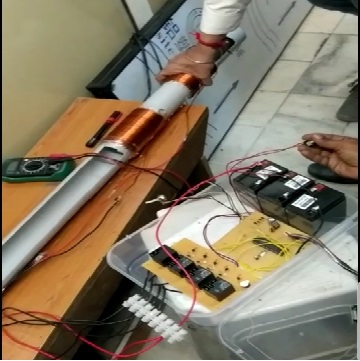
Title: Smart Sanitary Napkin Disposal Machine
Students Name – Shreyash K. Narayane, Anoop R. Shetty, Prajesh S. Shirsolkar, Shivraj B. Yadav
Project Details: – The machine will be ARDUINO driven with a display showing the current state of the machine and will be completely automatic. The machine would be in an idle state initially. Once the sanitary napkin enters the machine, the input would be first sensed by the Infrared Sensor – 1. Once the input pad is sensed, the upper flaps are opened and the pad would be allowed to enter the machine. The flap closes in a given time period (5- 10 seconds). Once the Infrared
Sensor – 1, senses the input, our process will be initiated. As soon as our process initiates, there will be a message displayed onto the screen displaying the current status of the machine. Then this input pad is allowed to pass through the narrow path and then is sensed by the Infrared Sensor – 2.Once the sensor
senses the input, the Lower flap will be opened and a message will be displayed onto the display screen displaying the current status of the machine. Meanwhile, the Heater and Exhaust fan, in the burning chamber, are set ON by the ATmega16.And hence, the pad then enters the burning chamber and
the burning process will start.This will continue until the burnt out pad ashes till maximum time allocated while ATmega16 (maximum 20-25 minutes).After the
time expires, the Heater is set OFF. The exhaust is kept ON and the Pump is set ON which flushes out
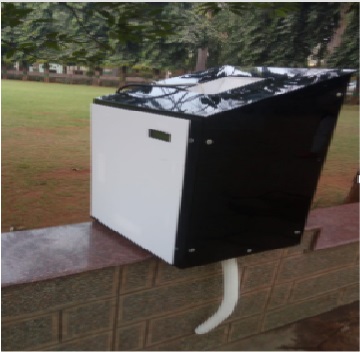
Projects 2018-19
PROJECT TITLE : – “OPTICAL WIRELESS DATA TRANSMISSION USING ENHANCEDCAESAR CIPHER ”
STUDENTS NAME: MINAKSHI PATIL , POOJA PATIL, SAYLI WANGIKAR
microcontroller based secured optical wireless communication system using laser and phototransistor. These days the usage of Wi-Fi has reached to every nook and corner of the world. There are some downsides belong to the usage of Wi-Fi such as those concerning to the speed, limited bandwidth, security and range of its usage. In order to overcome these hitches we can use the advanced version of Li-Fi which is efficient, high speed, and fully networked wireless communication. If light contains encrypted message then both privacy and prevention from unwanted access along with high data rate can be achievable from Li-Fi. A new encryption technique based on substitution of ASCII value of characters implemented and reliable data transmission carried out. The proposed encryption algorithm primarily follows Caesar Cipher Vigenere substitution, acts similarly with Caesar cipher that changes the ASCII value of original message according to predefined values and length of repetition based on key. Encryption of data, transmission, reception and conversion to original message are implemented successfully using laser, phototransistor, microcontroller and associated devices.
PROJECT TITLE : – “IOT BASED SMART AGRICULTURE”
STUDENTS NAME : – NAGNATH MHATRE, GAURAV PATIL, SURAJ PATIL, SWAPNIL RATHOD
Internet of Things (IoT) plays a crucial role in smart agriculture. Smart farming is an emerging concept, because IoT sensors capable of providing information about their agriculture fields. The project aims making use of evolving technology i.e. IoT and smart agriculture using automation. Monitoring environmental factors is the major factor to improve the yield of the efficient crops. The feature of this prpject includes monitoring temperature and humidity in agricultural field through sensors using arduino uno. Agriculture is the primary occupation in our country for ages. But now due to migration of people from rural to urban there is hindrance in agriculture. So to overcome this problem we go for smart agriculture techniques using IoT. This project includes various features like GPS based remote controlled monitoring, moisture & temperature sensing, intruders scaring, security, leaf wetness and proper irrigation facilities. It makes use of wireless sensor networks for noting the soil properties and environmental factors continuously. Various sensor nodes are deployed at different locations in the farm. Controlling these parameters are through any remote device or internet services and the operations are performed by interfacing sensors, Wi-Fi, camera with
microcontroller.
PROJECT TITLE : – “IoT based street light controller and energy monitoring system ”
STUDENTS NAME : – NISHANT KUPERKAR, SANKET SHILAWANT, PARESH MALI, POOJA DALAL
IoT based smart and adaptive lighting in street lights. The project is implemented with smart embedded system that controls the street light based on detection of
sunlight. During the night time the street light gets automatically ON and during the day time it gets automatically OFF. A Street light is a proposed source of light on the side of a road or walkway, which is turned on or lit at a certain time every night. Street lighting has been found to reduce walker crashes by nearly fifty percent. Street light monitoring & control is an automated system designed to increase the efficiency and accuracy of an enterprise by automatically timed controlled switching of street lights. This project describes a new practical solution of street light control systems. The system o includes the client-server mechanism where a user can directly interact with the web based application to manage the Street lamp of any place from the single position. The energy monitoring system enables the electricity department to read the meter readings monthly without a person visiting each house. This can be achieved by the use of Arduino unit that continuously monitor and records the energy meter reading in its permanent memory location. This system continuously records the reading and the live meter reading can be displayed on webpage to the consumer on request.
